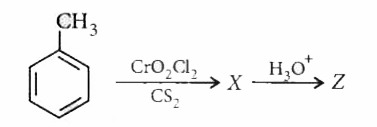Complete Solutions to CHEMISTRY of chapter KARNATAKA CET 2018 of Class 12 book with complete answers and questions
| Class 12 | CHEMISTRY |
| Chapter | KARNATAKA CET 2018 |
| KCET PREVIOUS YEAR PAPERS | CHEMISTRY |
| Number Of Questions | 60 |
| Academic Year | 2023-24 |
1.0 g of Mg is burnt with 0.28 g of `O_(2)` in a closed vessel. Which reactant is left in excess and how much ?
03:22View SolutionThe orbital nearest to the nucleus is
02:55View SolutionWhich of the following is the correct order of radius?
04:23View SolutionThe intramolecular hydrogen bond is present in
03:50View SolutionThe state of hybrid orbitals of carbon in `CO_(2), CH_(4) and CO_(3)^(2-)` respectively is
05:03View SolutionFor an ideal gas, compressibility factor is
01:55View SolutionThe relationship between `K_(p) and K_(c ) ` is `K_(p) = K_(c ) (RT) Delta n`. What would be the value of `Deltan` for the reaction `NH_(4) Cl (s) hArr NH_(3) (g) + HCl(g)` ?
01:37View SolutionAcidity of BF, can be explained on which of the following concepts ?
02:08View SolutionFor the redox reaction
`x MnO_(4)^(-) + yH_(2)C_(2)O_(4) + zH^(+) to m Mn^(2+) +n CO_(2) + p H_(2)O`
The valeu of x, y, m and n are02:44View Solution`H_2O_2` is
03:38View SolutionDead burnt plaster is
01:48View SolutionIdentify the following compound which exhibits geometrical isomerism:
03:44View SolutionDuring the fusion of organic compound with sodium metal, nitrogen present in the organic compound is converted into
01:50View SolutionThe reagent ' X ' used for the following reaction is
`R - C -= C- R'+H_2 overset(X)rarr` 02:36View Solution
02:36View SolutionWhich of the following ions will cause hardness in water ?
01:46View SolutionWhich of the following oxides shows electrical properties like metals?
01:39View SolutionWhich of the following aqueous solutions should have the highest boiling point?
02:40View SolutionThe charge required for the reduction of 1 mole of `MnO_(4)^(-) ` to `MnO_(2)` is
01:50View SolutionFor the reaction , `2SO_(2) +O_(2) hArr 2SO_(3)`,
the rate of disappearance of `O_(2)` is `2xx10^(-4)"mol L"^(-1)s^(-1)`. The rate of appearance of `SO_(3)` is03:00View SolutionWhich of the following electrolytes will have maximum coagulating value for `AgI//Ag^(+)` sol ?
02:47View SolutionElectrolytic refining is used to purify which of the following metals?
01:24View SolutionDry ice is
01:18View SolutionWhich of the following is an amphoteric oxide ?
03:57View SolutionThe IUPAC name of `[Co(NH_(3))_(4) Cl(NO_(2))] Cl` is
03:13View SolutionWhich of the following statements is true in case of alkyl halides?
02:21View SolutionPhenol can be distinguished from ethanol by the reagent
02:21View SolutionWhich of the following compounds undergoes haloform reaction ?
02:08View SolutionWhich of the following will be the most stable diazonium salt `(RN_(2)^(+) X^(-))` ?
02:29View SolutionWhich of the following bases is not present in DNA?
01:37View SolutionWhich one of the following is a polyamide polymer ?
01:36View SolutionIn F.C.C. the unit cell is shared equally by how many unit cells ?
02:08View SolutionAt a particular temperature, the ratio of molar conductance to specific conductance of 0.01 M NaCl solution is
02:41View SolutionIsotonic solutions are solutions having the same
01:59View SolutionThe temperature coefficient of a reaction is 2. When the temperature is increased from `30^(@)`C to `90^(@)`C, the rate of reaction is increased by
03:18View SolutionGold sol is not a
01:55View SolutionThe common impurity present in bauxite is
01:23View SolutionVery pure `N_(2)` can be obtained by
02:40View SolutionWhich of the following oxidation states is common for all lanthanides?
02:45View SolutionThe electronic configuration of transition element "X", is +3, oxidation state is `[Ar]3d^(5)`. What is its atomic number?
02:06View Solutionn-Propyl chloride reacts with sodium metal in dry ether to give
02:03View SolutionWhen the vapours of tertiary butyl alcohol are passed through heated copper at 573 K, the product formed is
03:56View SolutionWhat is the increasing order of acidic strength among the following ?
(i) p-methoxy phenol
(ii) p-methyl phenol
(iii) p-nitro phenol04:35View SolutionWhich of the following is more basic than aniline ?
03:10View SolutionThe two forms of D-Glucopyranose are called
03:25View SolutionAmong the following, the branched chain polymer is
04:53View SolutionEdge length of a cube is 300 pm. Its body diagonal would be
01:40View SolutionWhich of the following is not a conductor of electricity ?
01:53View SolutionFor a cell involving two electron changes, `E_("cell")^(@) =0.3V` at `25^(@)C`. The cell equilibrium constant of the reaction is
03:17View SolutionThe value of rate constant of a pseudo first order reaction
02:21View Solution`(CH_(3))_(3)` SiCl is used during polymerization of organosilicons because
03:03View SolutionWhen `Pb O_(2)` reacts with concentrated `HNO_(3)`, the gas evolved is
01:08View Solution`KMnO_(4)` acts as an oxidising agent in alkaline medium. When alkaline `KMnO_(4)` is treated with KI, iodide ion is oxidised to
01:33View Solution`[Fe (NO_(2))_(3) Cl_(3)] and [Fe (O-NO)_(3) Cl_(3)]` shows
02:09View SolutionTertiary alkyl halide is practically inert to substitution by `S_(N) 2` mechanism because of
02:09View SolutionThe products X and Z in the following sequence are
 05:15View Solution
05:15View SolutionThe appropriate reagent for the following transformation is
 02:37View Solution
02:37View SolutionIn the following reaction,

the compound Z is03:19View SolutionThe reaction of Benzenediazonium chloride with aniline yields yellow dye. The name of the yellow dye is
02:03View SolutionThe glycosidic linkage involved in linking the glucose units in amylose part of starch is
02:37View SolutionZiegler-Natta catalyst is used to prepare
01:56View Solution
CHEMISTRY questions and complete solutions for chapter KARNATAKA CET 2018 of KCET PREVIOUS YEAR PAPERS of Class 12
